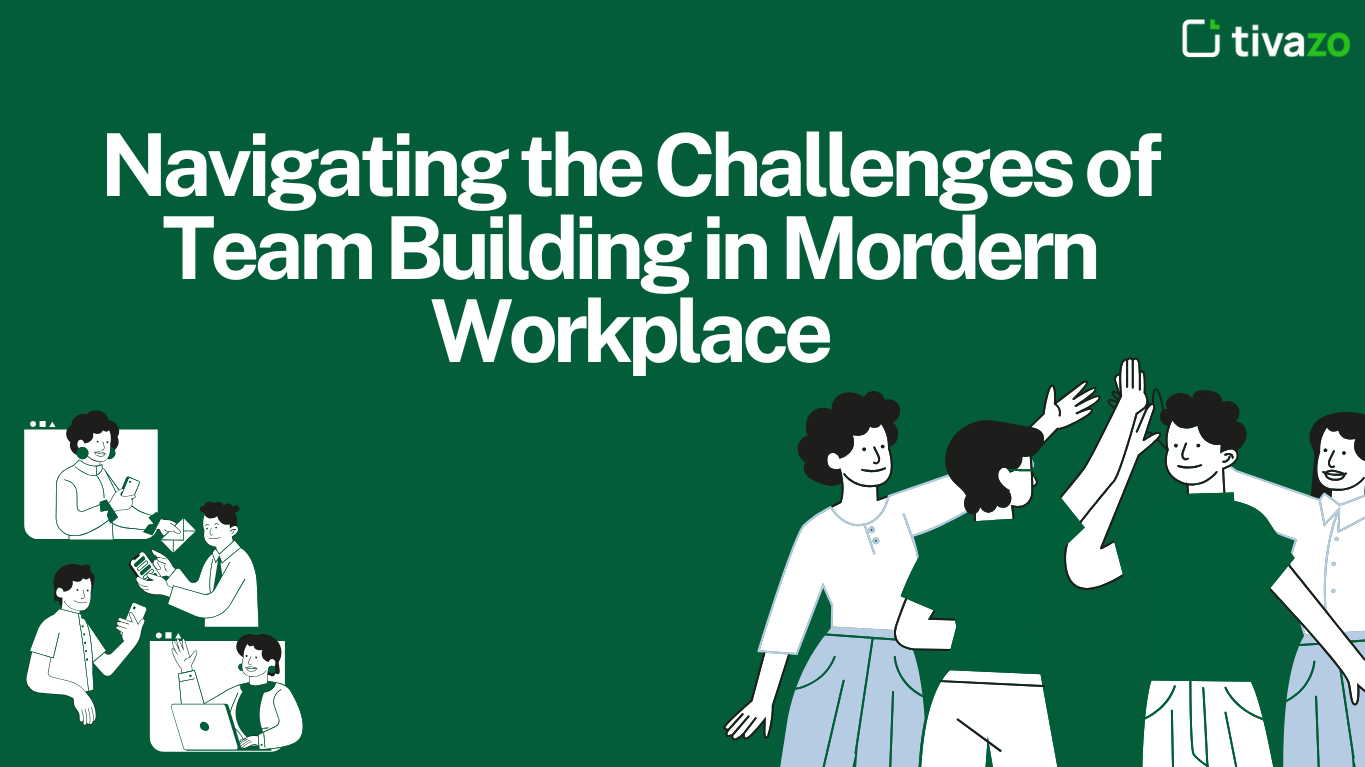Team building is important to create a collaborative atmosphere to encourage connections, increase morale, and bolster productivity in a time when the work atmosphere is rapidly changing. However, recognizing the importance of team building is simply the first step in a longer process. Developing team-building strategies, whether through events or learning opportunities, is fraught with obstacles, and the most irritating one is often overlooked, yet it is all too common.
The organizational complexities of hybrid work, the diverse personalities, and other typical challenges all contribute to one of the key elements of successful and sustainable team building: recognizing the challenges often overlooked and understanding the unseen barriers individuals and organizations face in team building of any kind. Let’s discuss the not-so-obvious challenges often faced in team building by organizations and their leaders.
Tackling the Digital Divide: The Hybrid / Remote Work Challenge
One of the biggest challenges today has to do with the recent use of remote and hybrid work. While it has the benefit for organizations of flexibility and access to talent pools, it will often create distance, both geographic distance and social distance, and inherently, distancing can complicate team building.
Loss of Informal Interactions
For instance, in an office setting, employees encounter each other casually, whether in a hallway, a coffee run, a lunch run, etc. These are the informal moments when connections and bonds are built. In remote work settings, largely due to distance, opportunities for interactions like this are not provided. This makes it harder for colleagues and teams to develop a working relationship outside of formal meeting structures and timelines, reducing informal team building opportunities.
Communication Distortion
As for communication, virtual communication tools have helped facilitate communication, but they are not in-person communication, which is richer with things like body language, tone, etc. Consequently, communication distortion can lead to misunderstandings, feelings of isolation, and/or slower trust from team members, which complicates the process of team building in a remote environment.
Time Zones
While this can be an issue in a hybrid work environment, it can also be very complicated and frustrating for organizations with teams that are distributed geographically. Trying to coordinate team-building activities (even when considering working hours) leads to a tenuous balancing act, and even feelings of exclusion or second-class citizenship for some team members (if meetings happen at different times and impact other meetings or events). Therefore, team building in these remote climates poses barriers to any inclusive and equitable team-building measures.
“Zoom fatigue” & “screen burnout”
Ironically, “virtual team building” can sometimes come to feel like just another meeting and therefore can contribute to the ongoing “Zoom fatigue” and screen burnout rather than reduce it. Employees are spending countless hours connecting remotely to complete their work responsibilities. Adding additional mandatory virtual interactions for “team building” purposes may be more harmful than good, if not designed intentionally. The success of these activities relies on the ability to have an engaging, interactive, and truly restorative experience that feels different than a traditional virtual meeting, where team-building is not an additional drain, but a restorative break from the other video calls.
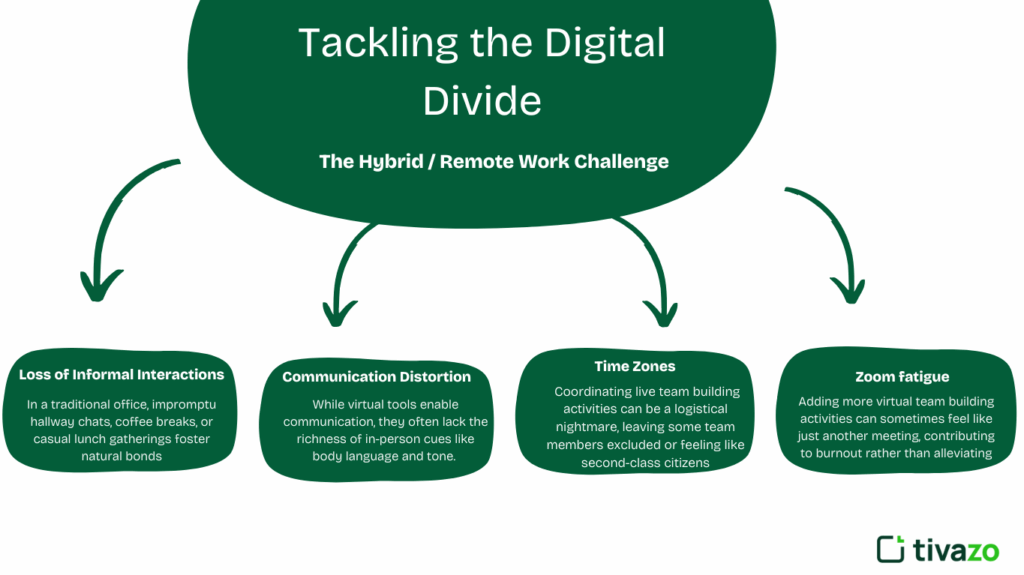
The “forced fun” syndrome: Resistance & Lack of Buy-in
Perhaps the most internal hurdle for team building is always going to be employee skepticism, cynicism, or even resistance. For many, frankly, team building is still synonymous with unnecessary interaction like awkward icebreakers, trust falls, or bland corporate retreats. If employees do not see value or buy into the “why,” team-building activities are going to fade fast into the “forced fun” category and will undoubtedly not result in any connection.
1. Seen as a Waste of Time
Finding team-building activities unimportant and a waste of precious work time. The employee, particularly if he/she is feeling the pressure of deadlines, will view these activities as an intrusion on real work. They will complain that they are not being productive or able to get to target, when in fact the activity may have bolstered or, at the very least, not inhibited their ability to do their job. At the outset, this mindset erodes the value of the entire team building event before it even gets off the ground. Leadership needs to convey a clear connection between the activity and practical business outcomes.
2. The “Cringe Factor”
Let’s be real: there are just some team-building activities that can be a tad, well, awkward. The kinds of activity can be placed into a cringe-inducing box because we didn’t carefully select them, we picked things that didn’t suit the personality of the team, or we chose to do poorly-facilitated activities that led down the cringe pathway. Ultimately, it’s a poor, awkward combination of discomfort, forced laughter, and a sense that it’s all a bit phoney.
When we push people into uncomfortable social situations, or a reveal of personal information too soon, this type of activity can turn into an accumulation of resentment rather than bonding. Team building is sensitive work and requires an awareness and understanding of the underlying dynamics and comfort levels inherent in the group as it is.
3. Lack of a Clear Purpose and Objective
Employees won’t find value in a team building exercise if they don’t know the purpose of the event or if the objectives have not been defined. If an activity feels random or like nothing to do with the day-to-day work, it will be difficult for employees to participate fully. For example, if a team is struggling with cross-functional communications, a team building exercise specifically designed for that issue will resonate far more than a generic game. Similarly, having a clear purpose is critical for team building.
4. Compulsory versus Optional
While participation in team building is usually required to some level to achieve objectives, applying “mandatory” to every single activity will backfire. Forcing attendance on employees can take the joy out of the events and become just another item to check off the list. Offering choices, providing clear value in advance, and creating a culture in which attendance rewards employees rather than feels mandatory will increase participation. The intimate connection that arises from team building work is not based on compulsion, but on willingness.
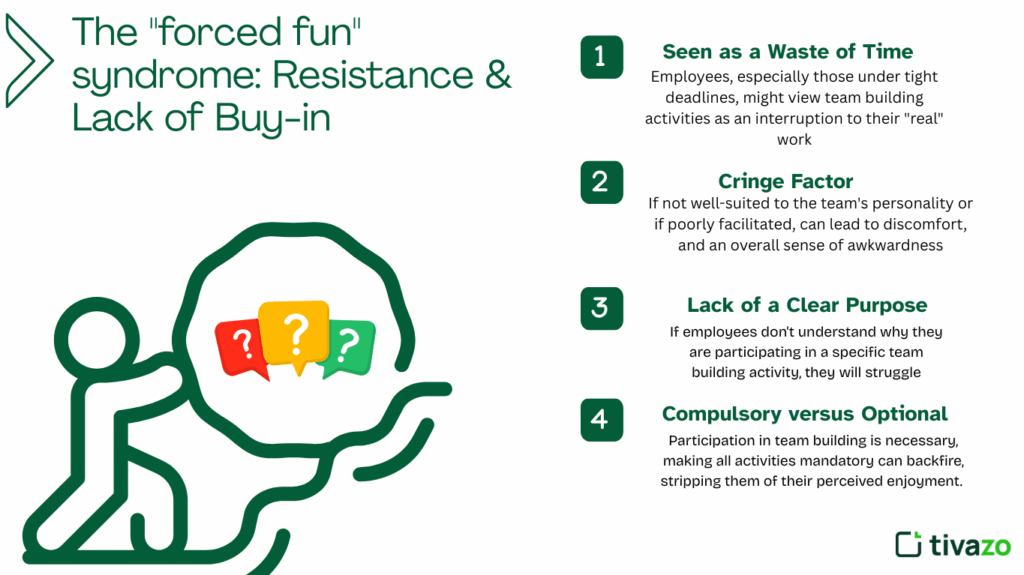
The One-Size-Fits-All Fallacy: Overlooking Diversity in Teams
Teams are seldom homogeneous. They are indeed a complex fabric of personality, culture, interests, communication styles, and comfort levels. Using a generic team building process that doesn’t consider this diversity will not work for a large portion of the group, and will therefore disengage a substantial segment of the team, and make the team building experience irrelevant to many.
- Introverts and Extroverts: An experience that relies a lot on public speaking or high-energy interaction may energize the extroverts in a team, but it could be a frustrating experience for the introverts in the group, who would agree that it is a better experience in a reflective or small group activity in team building.
- Cultural Differences: What one culture may find appropriate and value as a fun activity, another culture may not even understand, appreciate, or may even find offensive. Therefore, team-building strategies need to be culturally sensitive to accommodate everyone.
- Differing Interests: Not everyone will enjoy competitive games, physical challenges, or abstract problem solving; the ideal approach certainly has a variety of activities so their interests can be covered broadly in team building.
- Generational Gaps: The generational expectations would differ for how to interact with colleagues in the workplace and for team-building activities.
Evasion of Leadership Responsibility: Poor Commitment or Misdirected Execution.
Team building effectiveness starts with organizational leaders. Even with the best of intentions, poor fundamental activity by leadership may sabotage team building and result in short-circuiting overall organizational team building success.
- No Participation by Organizational Leaders: When leaders do not find time to be part of team-building engagement, don’t authentically champion team building, or don’t actively partake in building the activity/program, the workforce will quickly conclude that team building doesn’t matter or is just a “box” to check. Leadership’s lack of buy-in undermines any team-building program.
- Single Events and Irregular Activities: Team building does not occur just one-time. It is a continuous process. An organization that engages in retreat activities once a year or team-building activities on a sporadic basis does not significantly cultivate team-building value in the long term.
- No Feedback or Debriefing: The absence of “what happened, what did we learn, or how does this affect our daily work” encapsulates missed opportunities for authentic team-building growth and reinforcement of team-building.
- Disregarding Feedback: The absence of feedback from employees after team-building activities or following engagement is indicative of poor leadership behaviors and conveys that the organization will repeat poor activity that will not resonate with the team.
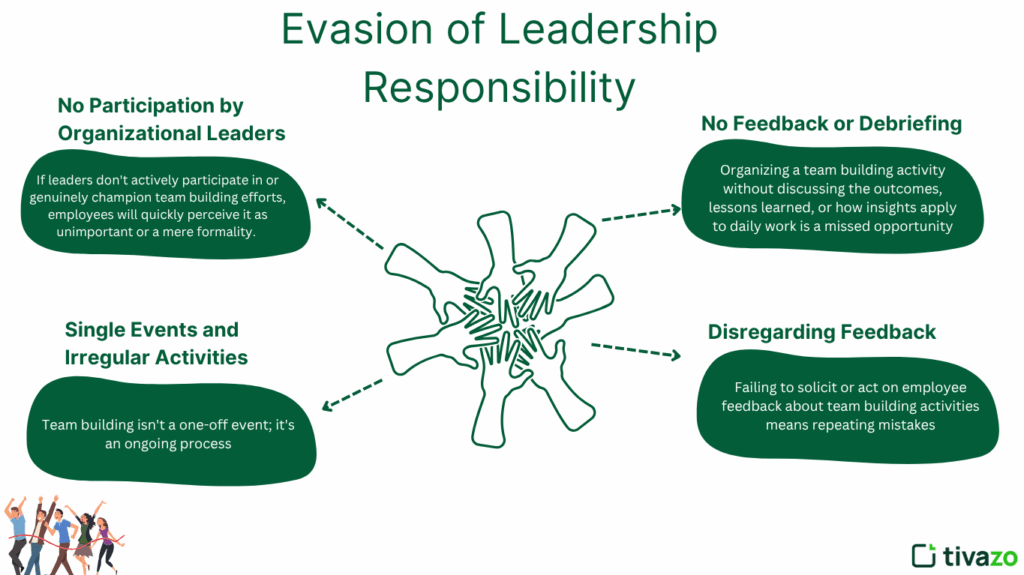
Measuring the “ Soft Skills ”: Proving ROI
In today’s world of scientific, data-driven decision-making, an ROI (Return on Investment) for “soft” initiatives like team building can be difficult, if not impossible, for some leaders to show.
1. Challenges in the Measurability of Impact
While we know that team building, by design, builds communication, trust, and collaboration, quantifying specific increases in revenue, improvements in cost efficiency, or savings in time due to team building can be a challenge. Oftentimes, the effects of team building are blended with so many other effects, it can be difficult to demonstrate cause and effect using hard numbers. The difficulty of allocating dollars directly to team building can make it hard to convince internal skeptics to spend more dollars on team building.
2. Short-Term vs. Long-Term Gains
The largest and most meaningful benefits of good team-building (like decreased employee turnover, improved innovation, good negotiation and problem-solving skills, and corporate culture) happen over time rather than in the instant after the team-building event. Because of the relativity to time, it may be difficult to generate an immediate ROI for team-building. In his report for StateNet, Author Steve Harrison says, “… budget system cycles and reporting procedures will not allow for the long-term gains, not to mention intangibles associated with team-building. As a rule, budget systems are focused on the short-term and track provides evidence of short-term gains.” Team building will be at a disadvantage to produce evidence when this evidence is only counted short term.
When there is a downturn in the economy, you will see that funds are strictly accounted for. All of a sudden, team-building is like discretionary spending and ranked last in priority.
Seen as “Expense” Rather than an “Investment”
When clear metrics aren’t present, persuasive case studies are lacking, or the organization does not have a strong and consistent narrative regarding the strategic utility of team building, team-building budgets can be the first to be eliminated in times of a market downturn or when organizations are trying to cut costs.
Team-building is typically seen as a discretionary part of the budget, a “nice-to-have” expense, and not a critical “must-have” investment in human capital. Organizations must engage in a conversation that redefines team-building beyond being just an expense.
Moving to a proactive and strategic approach for team-building
Recognizing these challenges is not to deter organizations from participating in team-building activities, but rather to help them think more purposefully and intentionally about team-building initiatives. Companies can create a better approach to team building by recognizing common pitfalls. Firms can take what they consider obstacles to their success and make the most of them, reinforcing their most important asset, their humans.
Here’s a way to overcome these challenges and create effective team building:
1. Intentional and Purposeful
Each team-building activity should have a communicated goal that is related to a specific team dynamic or aligned with broader business objectives. Don’t do a team-building activity for the sake of doing one.
2. Flexible and Inclusive
Provide many options for team building that appeal to different likes/dislikes, work systems (remote/hybrid), time zones, and cultures. Don’t forget about synchronous options, even if they are in small groups, in addition to differences in themes. The more inclusive you are in your options for team building, the more your requests may appeal to team members to participate.
3. Create Psychological Safety
Help foster an environment where employees feel safe to participate, share, take risks (within reason), or disengage if truly uncomfortable without fear of repercussions. Psychological safety is critical to encourage authentic connection through team-building elements.
4. Model Behavior
Leaders must publicly participate, enthusiastically, and champion team building. When leaders participate excitedly and openly, it sends an important message of the significance of team building to the rest of the organization.
5. Collect Feedback and Iterate
Always ask employees and solicit honest feedback about what types of team-building activities resonate and which don’t. Be willing to adapt, change, and allow your strategy to evolve. Iteration is essential to successful team building.
6. Emphasize Integration, Not Isolation
Team building should be as integrated into everyday work as possible through cross-functional assignments, mentorship, training, and joint problem-solving instead of developing separate/isolated events. Team building in a work-related context tends to produce the best and most long-lasting results.
7. Communicate the “Why”
Take the time to repeatedly explain to employees the value and benefits of team building, tying the team-building activity to their performance, morale, and company performance. Help them to understand the ROI of team building from their point of view.
8. Work on Facilitation Skills
Successful facilitation, whether through an internal or external consultant, is essential to having meaningful, engaging, and comfortable team-building experiences. Good facilitators can handle uncomfortable moments, promote everyone’s participation, and achieve all objectives.
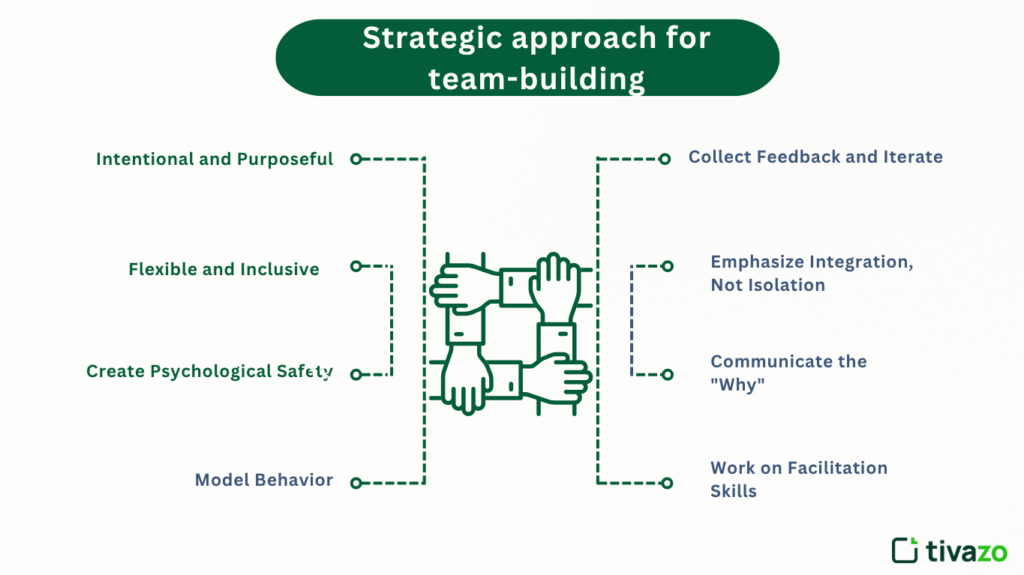
Conclusion
Consider that the modern workplace demands not just tools and deadlines, but authentic relationships and connections with others, and team building is how we first create those connections, then nurture them. Team building establishes your colleagues as colleagues, then collaborators, and finally, collaborators that become high-performing teams capable of addressing complex challenges. Whether you are leading a small remote team or accountable for a large, diverse workforce across multiple locations, your deliberate investment in and implementation of team building will yield a return in terms of engagement, innovation, and productivity that will be equal to the dollars and time that you invested.
In 2025 and beyond, it will be the organizations that actively prioritize people that continue to thrive, and team building is exactly where that begins. Because at the end of the day, it is all about creating resilient, nimble teams who are ready to both face the challenges as well as seize the opportunities that lie ahead.
